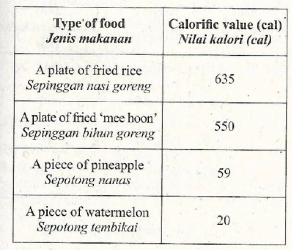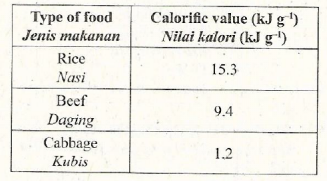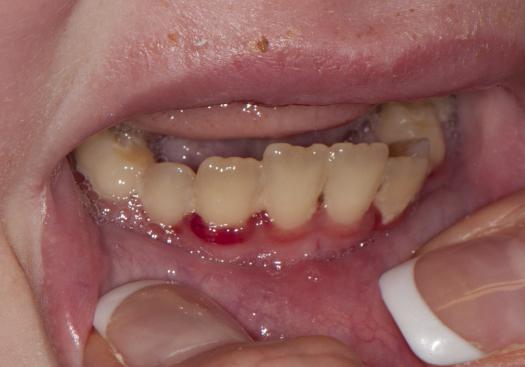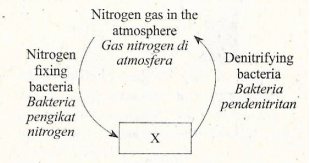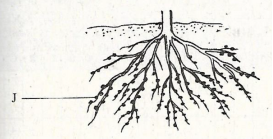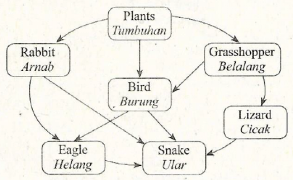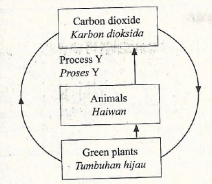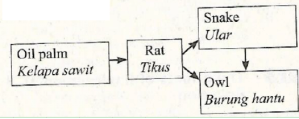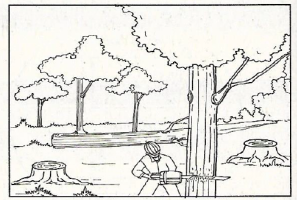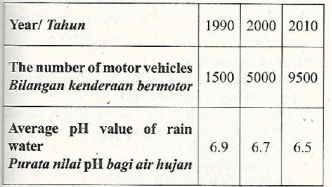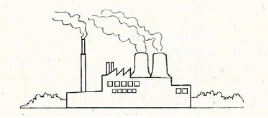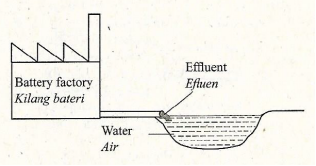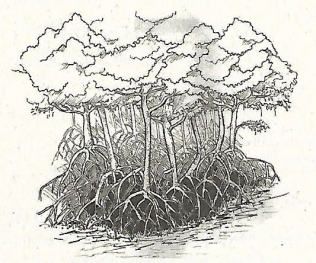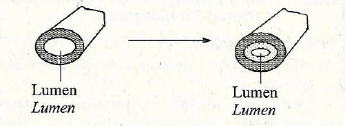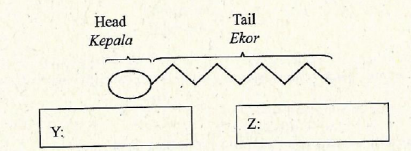Science Form 5 Topical Test 2

.
- 1.
Table shows the calorific values of certain type of food. Which set of food contain the highest calories?
- A.
A plate of fried rice and a piece of pineapple
- B.
A plate of fried rice and a piece of watermelon
- C.
A plate of fried ‘mee hoon’ and a piece of pineapple
- D.
A plate of fried ‘mee hoon’ and a piece of watermelon
Correct Answer
A. A plate of fried rice and a piece of pineappleExplanation
The set of food that contains the highest calories is a plate of fried rice and a piece of pineapple. This can be inferred from the given table, which shows the caloric values of certain types of food. Since fried rice typically has a high caloric content, and pineapple is known to be a relatively high-calorie fruit, combining these two items would result in the highest calorie count compared to the other options.Rate this question:
-
- 2.
Table shows the calorific value of three types of food. A student takes 200 g rice, 50 g beef and 10 g cabbage for his lunch. What is the total calorific value taken by the student?
- A.
25.9 kJ
- B.
285.9 kJ
- C.
3542.0 kJ
- D.
100 000.0 kJ
Correct Answer
C. 3542.0 kJExplanation
The table shows the caloric value of three types of food. To find the total caloric value taken by the student, we need to multiply the weight of each food item by its corresponding caloric value and then add them together. Assuming the caloric values are given in kJ (kilojoules), the calculation would be:
(200g rice * caloric value of rice) + (50g beef * caloric value of beef) + (10g cabbage * caloric value of cabbage) = total caloric value.
Since the answer is given as 3542.0 kJ, it can be inferred that the caloric values of the food items are such that when multiplied by their respective weights and added together, the result is 3542.0 kJ.Rate this question:
-
- 3.
The following information shows the diseases of a man caused by unhealthy eating habit. -Hypertension -Arteriosclerosis -Stroke Which food is suitable for this man?
- A.
Lamb soup
- B.
Steamed fish
- C.
Beef meat burger
- D.
Fried rice with chicken
Correct Answer
B. Steamed fishExplanation
The man is suffering from hypertension, arteriosclerosis, and stroke, which are all cardiovascular diseases. Unhealthy eating habits can contribute to the development and worsening of these conditions. Steamed fish is a suitable food choice because it is low in saturated fat, cholesterol, and sodium, which can help manage and improve cardiovascular health. Lamb soup, beef meat burger, and fried rice with chicken are likely to be high in saturated fat, cholesterol, and sodium, which can further exacerbate the man's health issues.Rate this question:
-
- 4.
Diagram shows a symptom caused by malnutrition. Which nutrient deficiency will cause the above disease?
- A.
Vitamin A
- B.
Vitamin B
- C.
Vitamin C
- D.
Vitamin D
Correct Answer
C. Vitamin CExplanation
A symptom caused by malnutrition is shown in the diagram. The nutrient deficiency that will cause this disease is Vitamin C.Rate this question:
-
- 5.
What causes health problems to humans?
- A.
Irregular meal time
- B.
Eat less but often
- C.
Eat according to the food pyramid
- D.
Choose healthy food
Correct Answer
A. Irregular meal timeExplanation
Irregular meal times can cause health problems in humans because it disrupts the body's natural rhythm and can lead to imbalances in blood sugar levels, digestion, and metabolism. When we eat at irregular times, our bodies may not be able to properly process and absorb nutrients, leading to deficiencies and other health issues. Additionally, irregular meal times can also disrupt our sleep patterns and contribute to weight gain or obesity. It is important to establish regular meal times to maintain a healthy lifestyle.Rate this question:
-
- 6.
Diagram shows a cross-section of an artery of a man.What is the disease that the man will suffer?
- A.
Kwashiorkor
- B.
Anaemia
- C.
Scurvy
- D.
Stroke
Correct Answer
D. StrokeExplanation
The diagram shows a cross-section of an artery, which is relevant to the disease of stroke. A stroke occurs when there is a blockage or rupture of blood vessels in the brain, leading to a lack of blood flow and oxygen to the affected area. The diagram suggests a problem with the artery, which could result in a stroke. Kwashiorkor, anaemia, and scurvy are unrelated to the circulatory system and would not be indicated by the diagram.Rate this question:
-
- 7.
The following information shows the symptoms observed by a farmer on his crops. -Stunted growth -Purple leaves -Poor root growth Which macronutrient needs to be added to the fertilizer?
- A.
Sulphur
- B.
Calcium
- C.
Nitrogen
- D.
Phosphorus
Correct Answer
D. PhosphorusExplanation
The symptoms described, such as stunted growth, purple leaves, and poor root growth, are indicative of a phosphorus deficiency in the crops. Phosphorus is an essential macronutrient that plays a crucial role in plant growth and development, particularly in root development and energy transfer processes. Therefore, adding phosphorus to the fertilizer would help address these symptoms and promote healthier crop growth.Rate this question:
-
- 8.
A farmer finds out that his mango trees leaves are yellow and bear fruits in low quantity. Which element is required in the fertilizer to overcome this problem?
- A.
Calcium
- B.
Nitrogen
- C.
Magnesium
- D.
Phosphorus
Correct Answer
B. NitrogenExplanation
Nitrogen is required in the fertilizer to overcome the problem of yellow leaves and low fruit quantity in mango trees. Nitrogen is an essential nutrient for plant growth and is responsible for the development of healthy green leaves and increased fruit production. Lack of nitrogen can result in yellowing of leaves and reduced fruit yield. Adding nitrogen to the soil through fertilizers can help restore the nutrient balance and improve the overall health and productivity of the mango trees.Rate this question:
-
- 9.
Which element is a macronutrient?
- A.
Iron
- B.
Zinc
- C.
Boron
- D.
Calcium
Correct Answer
D. CalciumExplanation
Calcium is a macronutrient because it is required in large amounts by plants and animals for various physiological functions. It is essential for the formation and maintenance of strong bones and teeth, muscle contraction, nerve function, and blood clotting. Calcium is also involved in cell signaling and plays a crucial role in maintaining normal heart rhythm. Iron, zinc, and boron are micronutrients, required in smaller quantities for specific functions in the body.Rate this question:
-
- 10.
The leaves of a plant become yellow. This can be overcome by adding fertilizer X. What is the function of the fertilizer X?
- A.
Synthesis chlorophyll
- B.
Promote cell division
- C.
Strengthens resistance toward diseases
- D.
Assist in the breakdown of starch
Correct Answer
A. Synthesis chlorophyllExplanation
Fertilizer X helps in the synthesis of chlorophyll. Chlorophyll is responsible for the green color in plants and is essential for photosynthesis, the process by which plants convert sunlight into energy. When the leaves of a plant become yellow, it indicates a lack of chlorophyll production. Adding fertilizer X provides the necessary nutrients for the plant to produce chlorophyll, thereby overcoming the yellowing of the leaves.Rate this question:
-
- 11.
Diagram shows part of nitrogen cycle. What is X? .
- A.
Nitrate
- B.
Ammonia
- C.
Nitrogen oxide
- D.
Nitrogen dioxide
Correct Answer
A. NitrateExplanation
X represents nitrate in the nitrogen cycle. Nitrate is a compound that contains nitrogen and oxygen. It is formed through the process of nitrification, where bacteria convert ammonia into nitrite, and then into nitrate. Nitrate is an important nutrient for plants and is taken up by their roots for growth and development. It can also be converted back into nitrogen gas through denitrification, completing the nitrogen cycle.Rate this question:
-
- 12.
Diagram shows a part of a nitrogen cycle. What is process X?
- A.
Nitrification
- B.
Denitrification
- C.
Decomposition
- D.
Nitrogen fixation
Correct Answer
A. NitrificationExplanation
The diagram shows a part of the nitrogen cycle, and the process being represented by X is nitrification. Nitrification is the process by which ammonia is converted into nitrite and then into nitrate by bacteria. This process is an important step in the nitrogen cycle as it converts ammonia, which is toxic to many organisms, into forms that can be used by plants for growth. Therefore, based on the information provided, nitrification is the most appropriate answer.Rate this question:
-
- 13.
Diagram shows the roots of a leguminous plant. What is the role of microorganism in J?
- A.
Convert nitrite to nitrate
- B.
Convert nitrate to nitrogen
- C.
Fix nitrogen to ammonia
- D.
Decompose ammonium compound to nitrite
Correct Answer
C. Fix nitrogen to ammoniaExplanation
Microorganisms play a crucial role in the process of nitrogen fixation, which is the conversion of atmospheric nitrogen into a usable form such as ammonia. Leguminous plants have a symbiotic relationship with nitrogen-fixing bacteria, which reside in their root nodules. These bacteria have the ability to convert atmospheric nitrogen gas into ammonia, which can be taken up by the plant and used for growth and development. Therefore, the role of microorganisms in J is to fix nitrogen to ammonia, providing an essential nutrient for the leguminous plant.Rate this question:
-
- 14.
Diagram shows root of a plant. Which plant has the above root?
- A.
Ground nut
- B.
Tapioca
- C.
Spinach
- D.
Maize
Correct Answer
A. Ground nutExplanation
The diagram shows a root that has small, round nodules attached to it. This characteristic is typical of the root system of a ground nut plant. Ground nut plants, also known as peanuts, have a unique root structure called "nitrogen-fixing nodules" that help the plant absorb nitrogen from the soil. This enables the plant to thrive in nutrient-poor soils. Therefore, based on the presence of these nodules in the diagram, the correct answer is ground nut.Rate this question:
-
- 15.
Diagram shows an example of a food web. Which of the following is a tertiary consumer?
- A.
Bird
- B.
Snake
- C.
Rabbit
- D.
Lizard
Correct Answer
B. SnakeExplanation
In a food web, a tertiary consumer is an organism that feeds on secondary consumers. In this case, the snake is the only option that fits this description, as it feeds on the rabbit, which is a secondary consumer. The bird, lizard, and rabbit are all either primary consumers or omnivores, not tertiary consumers. Therefore, the correct answer is snake.Rate this question:
-
- 16.
Diagram shows part of carbon cycle.What is process Y?
- A.
Photosynthesis
- B.
Respiration
- C.
Evaporation
- D.
Transpiration
Correct Answer
B. RespirationExplanation
The diagram shows part of the carbon cycle, which involves the movement of carbon between different reservoirs on Earth. Process Y in the diagram is the release of carbon dioxide back into the atmosphere, indicating the process of respiration. Respiration is the metabolic process by which organisms convert organic compounds into energy, producing carbon dioxide as a byproduct. This explanation is supported by the fact that photosynthesis is the process by which plants convert carbon dioxide into organic compounds, evaporation is the process of liquid water turning into water vapor, and transpiration is the release of water vapor from plants.Rate this question:
-
- 17.
Diagram shows a food chain in paddy field. What will happen to the paddy field yield and sparrow population if the grasshopper is eliminated?
- A.
Paddy yield: Increase Sparrow population: Increase
- B.
Paddy yield: Increase Sparrow population: Decrease
- C.
Paddy yield: Decrease Sparrow population: Increase
- D.
Paddy yield: Decrease Sparrow population: Decrease
Correct Answer
B. Paddy yield: Increase Sparrow population: DecreaseExplanation
If the grasshopper is eliminated, the paddy field yield will increase. This is because the grasshopper is a herbivore that feeds on the grass in the paddy field. By eliminating the grasshopper, there will be less competition for the grass and more resources available for the paddy plants to grow, resulting in a higher yield. However, the elimination of the grasshopper will also lead to a decrease in the sparrow population. Sparrows are predators that feed on the grasshoppers. Without the grasshoppers as a food source, the sparrow population will decrease due to a lack of prey.Rate this question:
-
- 18.
Which of the following is an example of natural disaster?
- A.
Forest fire
- B.
Flash flood
- C.
Earthquake
- D.
Landslide
Correct Answer
C. EarthquakeExplanation
An earthquake is an example of a natural disaster because it is a sudden and violent shaking of the ground caused by the movement of tectonic plates beneath the Earth's surface. Earthquakes can cause widespread destruction, including collapsing buildings, landslides, and tsunamis. They are natural events that occur due to geological processes and are beyond human control.Rate this question:
-
- 19.
Diagram shows the food web in an oil palm plantation. It is found that the yield has decreased. What is the best suggestion to solve this problem?
- A.
Kill the snakes
- B.
Clean the farm
- C.
Increase the number of owls
- D.
Increase the number of rats
Correct Answer
C. Increase the number of owlsExplanation
Increasing the number of owls is the best suggestion to solve the problem of decreased yield in the oil palm plantation. Owls are natural predators of rats, which are likely causing damage to the crops. By increasing the number of owls, the population of rats can be controlled, reducing their impact on the yield. This will help to restore the balance in the food web and improve the overall productivity of the plantation.Rate this question:
-
- 20.
What is the effect if excessive uses of chlorofluorocarbon (CFC) is uncontrolled? *One or more answers may be correct.
- A.
Many people will suffer from skin cancer
- B.
The temperature of the Earth decreases
- C.
Excessive growth of algae
- D.
Plants' leaves and chlorophylls are damaged
Correct Answer(s)
A. Many people will suffer from skin cancer
D. Plants' leaves and chlorophylls are damagedExplanation
Excessive use of chlorofluorocarbon (CFC) can lead to the depletion of the ozone layer, which protects the Earth from harmful ultraviolet (UV) radiation. This can result in an increased risk of skin cancer for many people. Additionally, CFCs can also have a damaging effect on plants, causing damage to their leaves and chlorophylls.Rate this question:
-
- 21.
Diagram shows a human activity. What is the effect of this activity?
- A.
Prevent the greenhouse effect
- B.
Increases the water catchment area
- C.
Preserves the flora and fauna in the forest
- D.
Increases the carbon dioxide content in the atmosphere
Correct Answer
D. Increases the carbon dioxide content in the atmosphereExplanation
The diagram shows a human activity that increases the carbon dioxide content in the atmosphere. This means that the activity is releasing carbon dioxide into the air, which contributes to the greenhouse effect and climate change.Rate this question:
-
- 22.
Which phenomenon is directly related to chlorofluorocarbon (CFC) ?
- A.
Haze
- B.
Ozone depletion
- C.
Global warming
- D.
Greenhouse effect
Correct Answer
B. Ozone depletionExplanation
Chlorofluorocarbons (CFCs) are a group of chemicals that contain carbon, chlorine, and fluorine. When released into the atmosphere, CFCs can rise to the stratosphere and interact with ozone molecules, leading to their destruction. This process is known as ozone depletion. Ozone depletion is a phenomenon that results in the thinning of the ozone layer, which protects the Earth from harmful ultraviolet (UV) radiation. The depletion of the ozone layer can have serious consequences, including increased UV radiation reaching the Earth's surface, which can harm human health and ecosystems.Rate this question:
-
- 23.
Table shows the number of motor vehicles and pH value of rain water in an area. What will happen in year 2020? *One or more answers may be correct.
- A.
The number of motor vehicles increases
- B.
The number of motor vehicles decreases
- C.
Average pH value of rain water increases
- D.
Average pH value of rain water decreases
Correct Answer(s)
A. The number of motor vehicles increases
D. Average pH value of rain water decreasesExplanation
In year 2020, the number of motor vehicles is expected to increase based on the information provided in the table. Additionally, the average pH value of rain water is expected to decrease.Rate this question:
-
- 24.
Which of the following usage can cause environmental pollution?
- A.
Solar energy
- B.
Crop rotation
- C.
Biological control
- D.
Chemical fertilizer
Correct Answer
D. Chemical fertilizerExplanation
Chemical fertilizers can cause environmental pollution because they contain harmful chemicals that can leach into the soil and water sources. These chemicals can disrupt the natural balance of ecosystems and harm plants, animals, and aquatic life. Additionally, the production and transportation of chemical fertilizers can also contribute to air pollution and greenhouse gas emissions. On the other hand, solar energy, crop rotation, and biological control methods are environmentally friendly and do not cause pollution.Rate this question:
-
- 25.
Diagram shows a cause of pollution in an area. What is the effect of the pollution to the residents nearby?
- A.
Diarrhoea
- B.
Bronchitis
- C.
Haemophilia
- D.
Skin cancer
Correct Answer
B. BronchitisExplanation
The diagram shows a cause of pollution in an area, but it does not specify the type of pollution. However, bronchitis is a common respiratory condition that can be caused by air pollution. Therefore, it can be inferred that the effect of the pollution on the residents nearby is bronchitis.Rate this question:
-
- 26.
What problem will arise if excess fertiliser is flowed into a river? *One or more answers may be correct.
- A.
Temperature of river increases
- B.
Algae growth increases
- C.
River will become shallow
- D.
Oxygen content decreases.
Correct Answer(s)
B. Algae growth increases
D. Oxygen content decreases.Explanation
If excess fertilizer is flowed into a river, the increased nutrient levels can lead to excessive growth of algae. This can create an imbalance in the ecosystem, as the algae can block sunlight from reaching other aquatic plants and also deplete oxygen levels in the water. Additionally, the increased algae growth can lead to eutrophication, which can harm fish and other aquatic organisms. Therefore, the correct answers are "Algae growth increases" and "Oxygen content decreases."Rate this question:
-
- 27.
The information shows the gases which cause environmental pollution. - Sulphur dioxide - Nitrogen dioxide What is the effect of these gases?
- A.
Eutrophication
- B.
Acid rain
- C.
Global warming
- D.
Depletion of ozone layer
Correct Answer
B. Acid rainExplanation
Sulphur dioxide and nitrogen dioxide are known to contribute to the formation of acid rain. When these gases are released into the atmosphere, they react with water, oxygen, and other chemicals to form sulfuric acid and nitric acid. These acids then fall back to the earth as acid rain, which can have harmful effects on the environment, including damage to plants, buildings, and bodies of water.Rate this question:
-
- 28.
Diagram shows pollution caused by a factory. What is the best method to reduce water pollution?
- A.
Rear fish in the water
- B.
Flow the effluent to open sea
- C.
Treat the effluent before released
- D.
Test the amount of pollutants in water regularly
Correct Answer
C. Treat the effluent before releasedExplanation
Treating the effluent before it is released is the best method to reduce water pollution caused by a factory. This process involves removing or reducing harmful pollutants and contaminants from the effluent before it is discharged into the water. By treating the effluent, the factory can ensure that the water being released is cleaner and less harmful to the environment. This method helps to prevent the pollution of water bodies and protects aquatic life.Rate this question:
-
- 29.
Diagram shows the condition of a natural forest. Which of the following is the best method to maintain the condition of the forest?
- A.
Biological control
- B.
Preservation and conservation
- C.
Renewing source of energy
- D.
Control the usage of pesticide
Correct Answer
B. Preservation and conservationExplanation
Preservation and conservation is the best method to maintain the condition of the forest. This involves protecting the forest from human activities such as deforestation and illegal logging. It also includes implementing measures to conserve the biodiversity within the forest and ensuring sustainable use of its resources. By preserving and conserving the forest, it can continue to thrive and provide important ecosystem services such as carbon sequestration, habitat for wildlife, and clean air and water. This method promotes long-term sustainability and ensures the forest's health and vitality.Rate this question:
-
- 30.
Authorities has banned the opening of land which exceed an altitude of 1000m above sea level and the steepness more than 40 degrees. What is the main purpose of this regulation?
- A.
Decrease the amount of carbon dioxide gas released
- B.
Increase the growth of flora and faun
- C.
Decrease the soil erosion
- D.
Increase the soil fertility
Correct Answer
C. Decrease the soil erosionExplanation
The main purpose of the regulation is to decrease soil erosion. By banning the opening of land above 1000m altitude and with steepness over 40 degrees, the authorities aim to prevent soil erosion caused by activities such as deforestation or construction. This regulation helps to preserve the topsoil and prevent it from being washed away by rain or wind, which can lead to degradation of the land and loss of fertility.Rate this question:
-
- 31.
Fill in the blanks with the words given. increase decrease maintain Uncontrolled logging will ________ the population of producer. Therefore, the quantity of carbon dioxide in atmosphere will ________
Correct Answer
decrease
increaseExplanation
Uncontrolled logging will decrease the population of producers. Therefore, the quantity of carbon dioxide in the atmosphere will increase.Rate this question:
- 32.
Which of the following is a characteristic of organic compounds? *One or more answers may be correct.
- A.
Flammable
- B.
High melting point
- C.
Highly soluble in water
- D.
Originated from plants and animals
Correct Answer(s)
A. Flammable
D. Originated from plants and animalsExplanation
Organic compounds are characterized by being flammable and originating from plants and animals. Flammability is a common characteristic of organic compounds due to the presence of carbon-carbon bonds, which are highly reactive and can easily undergo combustion reactions. Additionally, organic compounds are derived from living organisms, such as plants and animals, and are composed primarily of carbon atoms bonded to hydrogen atoms, along with other elements like oxygen, nitrogen, and sulfur. High melting point and high solubility in water are not general characteristics of organic compounds, as their physical properties can vary widely depending on their specific molecular structure.Rate this question:
-
- 33.
The following information shows the characteristics of substance R. - Consist of carbon and hydrogen only -Originated from dead animals and plants What is R?
- A.
Milk
- B.
Diamond
- C.
Graphite
- D.
Petroleum
Correct Answer
D. PetroleumExplanation
Petroleum is the correct answer because it consists of carbon and hydrogen only, and it is formed from the remains of dead animals and plants over millions of years. Milk, diamond, and graphite do not fit both characteristics, as they have different compositions or origins.Rate this question:
-
- 34.
The following word equation shows a chemical reaction. What is the reaction?
- A.
Polymerisation
- B.
Dehydration
- C.
Fermentation
- D.
Esterification
Correct Answer
C. FermentationExplanation
The correct answer is fermentation. Fermentation is a chemical reaction that involves the breakdown of sugars by microorganisms, such as yeast or bacteria, in the absence of oxygen. This process produces energy in the form of ATP and results in the production of alcohol or acids, depending on the specific microorganism involved.Rate this question:
-
- 35.
A colourless liquid spilled on the hand of a student. He felt cold on that area and the liquid instantly dried. What is the liquid?
- A.
Ethanol
- B.
Vinegar
- C.
Salt solution
- D.
Distilled water
Correct Answer
A. EthanolExplanation
Ethanol is a colorless liquid that has a cooling effect when it comes into contact with the skin. It evaporates quickly, which explains why the liquid dried instantly. Vinegar, salt solution, and distilled water do not have the same properties as ethanol and would not cause the same sensations or evaporate as quickly. Therefore, the most likely liquid in this scenario is ethanol.Rate this question:
-
- 36.
A student is assigned to produce ethanol but he has run out of sugar solution. Which of the following is the most suitable to replace the sugar solution?
- A.
Cucumber
- B.
Chili
- C.
Eggplant
- D.
Pineapple
Correct Answer
D. PineappleExplanation
Pineapple is the most suitable to replace the sugar solution because it contains natural sugars, specifically fructose, which can be fermented to produce ethanol. Cucumber, chili, and eggplant do not contain significant amounts of sugars and therefore would not be suitable replacements.Rate this question:
-
- 37.
The following word equation shows a chemical reaction.What is Y?
- A.
Salt
- B.
Alkali
- C.
Organic acid
- D.
Inorganic acid
Correct Answer
C. Organic acidExplanation
The word equation shows a chemical reaction involving salt, alkali, organic acid, and inorganic acid. Among these options, the correct answer is organic acid. This is because organic acids are a type of acid that is derived from living organisms and contain carbon atoms. In contrast, inorganic acids are derived from non-living sources and do not contain carbon atoms. Therefore, the presence of organic acid in the word equation suggests that it is involved in the chemical reaction.Rate this question:
-
- 38.
Diagram shows a change in size of the lumen artery. Which food if taken excessively, will cause the change?
- A.
Biscuit
- B.
Banana
- C.
Vegetable soup
- D.
Fried chicken
Correct Answer
D. Fried chickenExplanation
Excessive consumption of fried chicken can cause a change in the size of the lumen artery. Fried chicken is high in unhealthy fats and cholesterol, which can lead to the development of plaque in the arteries. This can cause the arteries to narrow, reducing the size of the lumen and restricting blood flow.Rate this question:
-
- 39.
Which of the following is an example of unsaturated fat?
- A.
Meat
- B.
Butter
- C.
Olive oil
- D.
Goatmilk
Correct Answer
C. Olive oilExplanation
Olive oil is an example of unsaturated fat because it contains a high proportion of monounsaturated and polyunsaturated fats. These types of fats have double bonds in their chemical structure, which makes them liquid at room temperature. Unsaturated fats are considered to be healthier than saturated fats because they can help lower bad cholesterol levels and reduce the risk of heart disease. In contrast, meat and butter are examples of saturated fats, which are solid at room temperature and can raise bad cholesterol levels. Goat milk can contain both saturated and unsaturated fats, but it is not specifically mentioned which type predominates.Rate this question:
-
- 40.
The following information shows the uses of substances Y. What is Y?
- A.
Starch
- B.
Palm oil
- C.
Petroleum
- D.
Common salt
Correct Answer
B. Palm oilExplanation
The correct answer is palm oil because it is a substance that can be used for various purposes. It can be used in cooking as a cooking oil, as an ingredient in food products, and in the production of cosmetics and personal care products. Palm oil is also used in the production of biofuels and as a lubricant in machinery.Rate this question:
-
- 41.
Diagram shows a cross-section of an oil palm fruit. Which part, A, B, C or D can produce kernel oil?
- A.
A
- B.
B
- C.
C
- D.
D
Correct Answer
B. BExplanation
Part B can produce kernel oil because it is located in the center of the fruit and is surrounded by the flesh. Kernel oil is derived from the seed or kernel of the oil palm fruit, and part B represents the seed or kernel.Rate this question:
-
- 42.
The following information shows one stage in palm oil extraction. The palm oil bunches are steamed. What is the purpose of this stage?
- A.
Decolourise
- B.
Extracts palm oil
- C.
Kill microorganism
- D.
Eliminates the odour
Correct Answer
C. Kill microorganismExplanation
Steaming the palm oil bunches in the extraction process serves the purpose of killing microorganisms. The high temperature of the steam effectively eliminates any microorganisms present in the bunches, ensuring the safety and quality of the extracted palm oil. This step is crucial in preventing the growth of harmful bacteria and preserving the integrity of the final product.Rate this question:
-
- 43.
The following information shows the stages in the extraction of palm oil. P - Digestion Q - Purification R - Sterilisation S - Extraction Which sequence is correct?
- A.
P→S→Q→R
- B.
P→R→S→Q
- C.
R→P→S→Q
- D.
R→P→Q→S
Correct Answer
C. R→P→S→QExplanation
The correct sequence for the extraction of palm oil is R (Sterilisation) followed by P (Digestion), then S (Extraction), and finally Q (Purification). Sterilisation is the first step in the process, where the palm fruit bunches are sterilized to kill any bacteria or fungi. Digestion comes next, where the sterilized fruit is broken down to release the oil. Extraction is then done to separate the oil from the fruit pulp. Lastly, purification is carried out to remove any impurities from the extracted oil.Rate this question:
-
- 44.
The following word equation shows an equation in making soap. What is X?
- A.
Acid
- B.
Glucose
- C.
Palm oil
- D.
Distilled water
Correct Answer
C. Palm oilExplanation
In the process of making soap, palm oil is one of the main ingredients used. It provides the necessary fats that help in creating a solid bar of soap. Palm oil is rich in fatty acids, which react with the other ingredients like acid, glucose, and distilled water to form soap through a process called saponification. Therefore, X in the word equation represents palm oil.Rate this question:
-
- 45.
A rubber tapper found that his latex coagulated before reaching the collection centre. What is the method to overcome his problem?
- A.
Adding acid into the latex
- B.
Adding water into the latex
- C.
Adding ammonia solution into the latex
- D.
Put latex into a covered container
Correct Answer
C. Adding ammonia solution into the latexExplanation
Adding ammonia solution into the latex can help prevent coagulation before reaching the collection center. Ammonia acts as a stabilizer and prevents the latex from coagulating by maintaining its liquid state. This method helps the rubber tapper to ensure that the latex remains in a usable form until it reaches the collection center.Rate this question:
-
- 46.
Which diagram represents a vulcanised rubber?
- A.
Option 1
- B.
Option 2
- C.
Option 3
- D.
Option 4
Correct Answer
D. Option 4Explanation
Option 4 represents a vulcanised rubber because it shows a diagram of rubber that has undergone the vulcanisation process. Vulcanisation is a chemical process in which rubber is treated with sulfur or other curatives to improve its strength, elasticity, and durability. The diagram in Option 4 shows cross-linking of rubber molecules, which is a characteristic of vulcanised rubber.Rate this question:
-
- 47.
Diagram shows the structure of a soap molecule Name the part Y and Z using the following words given. Y: ________ Z: ________ hydrophobic Hydrolysis hydrophilic
Correct Answer
hydrophilic
hydrophobicExplanation
Y is hydrophilic and Z is hydrophobic. This is because hydrophilic molecules are attracted to water and can dissolve in it, while hydrophobic molecules repel water and do not dissolve in it.Rate this question:
- 48.
A farmer wants to use a natural method to control pest at his farm. What should he use?
- A.
Pesticides
- B.
Biological control
- C.
Natural fertilizer
- D.
Chemical fertilizer
Correct Answer
B. Biological controlExplanation
The farmer should use biological control to control pests at his farm. Biological control involves using natural predators, parasites, or pathogens to control pests. This method is considered more environmentally friendly and sustainable compared to using pesticides or chemical fertilizers. Natural fertilizers are used to improve soil fertility and do not directly control pests.Rate this question:
-
Quiz Review Timeline +
Our quizzes are rigorously reviewed, monitored and continuously updated by our expert board to maintain accuracy, relevance, and timeliness.
-
Current Version
-
Mar 21, 2023Quiz Edited by
ProProfs Editorial Team -
May 13, 2020Quiz Created by
Grace
 Back to top
Back to top



